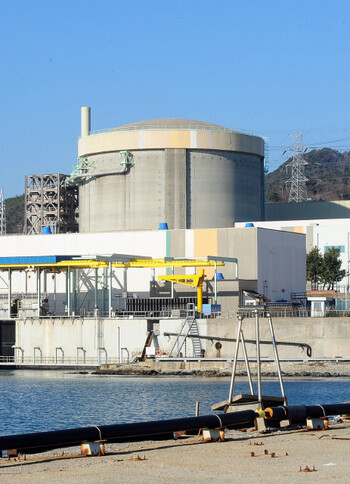hankyoreh
Links to other country sites 다른 나라 사이트 링크
Canadian province shuts down nuclear reactor similar to Wolseong

By Lee Keun-young, science correspondent
“The Quebec Provincial government recently decided that the nuclear reactor Gentilly-2, the same type as Korea’s Wolseong #1, would be shutdown due to safety concerns and the huge cost of extending its term of service. South Korea needs to follow Quebec’s lead and adopt such a process of discussion in which the extension of operations is approved only after calculating the costs and making public the relevant information.”
Greenpeace Canada nuclear campaigner Shawn Patrick Stensil, 39, advised as much in a video press conference held on Nov. 19 by South Korean NGO Common Action for a Non-Nuclear Society and Greenpeace Korea. He mentioned the case of Point Lepreau, a single nuclear power plant whose original lifespan was extended. The original estimation of the plant’s facilities improvement costs was CDN$800 million in 2002, but the cost ballooned to CDN$1.1 billion won in 2005 and CDN$2.5 billion won in 2010.
Power company Hydro Quebec had pushed for an extension of operations at Gentilly-2, which began operation in 1983. It finally decided to close the plant after estimated expenses surpassed CDN$4 billion. Gentilly-2, whose lifespan is set to expire on Nov. 20, is a CANDU reactor with a design similar to Wolseong reactor #1. Korea Hydro & Nuclear Power (KHNP) had replaced some components of Wolseong reactor #1, including a pressure tube at the expense of 700 billion won in 2009 and applied for an extension of the facility’s term of operation from the Nuclear Safety and Security Commission. The extension was not approved due to problems with the emergency cooling heat exchanger.
Stensil, who has been monitoring the CANDU type nuclear reactor over the past ten years, said that in Canada, the approval process of lifespan extension starts after the expense of facility improvement is estimated based on safety inspections and an environmental impact assessment is made followed by a round of public hearings with local residents.
Concerning the CANDU type nuclear reactor, Stensil said the International Atomic Energy Agency (IAEA) ruled that it failed to meet common nuclear reactor safety standards as the reactor displays “positive reactivity” when incidents occur unlike other reactors in which fission chain reaction reduces during incidents. He added that if safety standards are strengthened, the expense for maintaining the reactor will rise, thereby lowering its economic feasibility. One head of a nuclear safety regulatory agency in Canada, who sought to step up safety regulations, was even dismissed by the industry lobby, he said.
“The lesson we learned from the Fukushima nuclear disaster is that chain incidents can occur when nuclear power reactors are gathered,” Stensil said. When deciding whether Wolseong reactor #1’s operations are to be extended, such lessons should be taken into account before anything else, he advised.
Canada shut down two out of 22 operating reactors and seven additional reactors (including Gentilly-2) are expected to be shut down by 2020. Stensil said the province of Ontario saw a drop in its electricity costs after the shutdown of nuclear power plant due to energy savings and efficiency measures combined with investment in new renewable energy development.
Please direct questions or comments to [english@hani.co.kr]

Editorial・opinion
![[Column] Season 2 of special prosecutor probe may be coming to Korea soon [Column] Season 2 of special prosecutor probe may be coming to Korea soon](https://flexible.img.hani.co.kr/flexible/normal/500/300/imgdb/original/2024/0426/3317141030699447.jpg) [Column] Season 2 of special prosecutor probe may be coming to Korea soon
[Column] Season 2 of special prosecutor probe may be coming to Korea soon![[Column] Park Geun-hye déjà vu in Yoon Suk-yeol [Column] Park Geun-hye déjà vu in Yoon Suk-yeol](https://flexible.img.hani.co.kr/flexible/normal/500/300/imgdb/original/2024/0424/651713945113788.jpg) [Column] Park Geun-hye déjà vu in Yoon Suk-yeol
[Column] Park Geun-hye déjà vu in Yoon Suk-yeol- [Editorial] New weight of N. Korea’s nuclear threats makes dialogue all the more urgent
- [Guest essay] The real reason Korea’s new right wants to dub Rhee a founding father
- [Column] ‘Choson’: Is it time we start referring to N. Korea in its own terms?
- [Editorial] Japan’s rewriting of history with Korea has gone too far
- [Column] The president’s questionable capacity for dialogue
- [Column] Are chaebol firms just pizza pies for families to divvy up as they please?
- [Column] Has Korea, too, crossed the Rubicon on China?
- [Correspondent’s column] In Japan’s alliance with US, echoes of its past alliances with UK
Most viewed articles
- 1[Column] Season 2 of special prosecutor probe may be coming to Korea soon
- 2‘We must say no’: Seoul defense chief on Korean, USFK involvement in hypothetical Taiwan crisis
- 3Is N. Korea threatening to test nukes in response to possible new US-led sanctions body?
- 4Division commander ordered troops to enter raging flood waters before Marine died, survivor says
- 5Amnesty notes ‘erosion’ of freedom of expression in Korea in annual human rights report
- 6Is Japan about to snatch control of Line messenger from Korea’s Naver?
- 7No good, very bad game for Korea puts it out of Olympics for first time since 1988
- 8[Editorial] Korea’s surprise Q1 growth requires objective assessment, not blind fanfare
- 9N. Korean delegation’s trip to Iran shows how Pyongyang is leveraging ties with Moscow
- 10Korea’s 1.3% growth in Q1 signals ‘textbook’ return to growth, says government